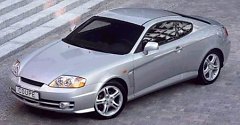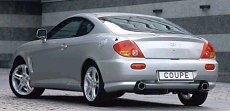 Hyundai
wants to sell 80,000 Tuscani each year, which is quite ambitious these
days. 15 years ago, selling up to 100,000 coupes annually was a
comfortable
task to Japanese car makers, because price and quality were on their
side.
How can they produced coupes so cheap ? because they utilized component
sharing with their mass production sedans. As the market trend switched
to roadsters, whose distinctive construction made platform sharing
impossible,
Japanese found themselves slipping. At the same time, traditional coupe
market was being eaten by roadsters, hot hatches, RVs and the like of
WRX,
that means producing an affordable yet high-quality coupe became more
and
more difficult. Today, only Toyota Celica and Honda Integra are
surviving
in the international market. Hyundai
wants to sell 80,000 Tuscani each year, which is quite ambitious these
days. 15 years ago, selling up to 100,000 coupes annually was a
comfortable
task to Japanese car makers, because price and quality were on their
side.
How can they produced coupes so cheap ? because they utilized component
sharing with their mass production sedans. As the market trend switched
to roadsters, whose distinctive construction made platform sharing
impossible,
Japanese found themselves slipping. At the same time, traditional coupe
market was being eaten by roadsters, hot hatches, RVs and the like of
WRX,
that means producing an affordable yet high-quality coupe became more
and
more difficult. Today, only Toyota Celica and Honda Integra are
surviving
in the international market.
Even though under such background, Tuscani does not try to deviate from the successful formula the Japanese established decades ago. Apart from keen pricing, it followed the Japanese' footprints to upgrade build quality to match or even surpass rivals at the same price range - Japanese included now. Look at the interior and you'll see what I mean - the plastic used are obviously more expensive than, say, a Celica. In many ways it looks and feels very like Ford Mondeo, such as the texture over plastic surfaces, the metal-effect console panel and dials with chromed rims. Assembly are generally faultless, which is hardly any surprise for the post-XG Hyundai. The outlook design is also very well executed. Generally speaking, it looks handsomer than the new Integra. Comparing it with Celica and Silvia is more difficult, since the new Hyundai coupe tries to look expensive rather than aggressive. Again, it was styled by American in the company's California studio, no wonder from the side it looks similar to Ford Mustang. However, we still have to criticize the designer because he obviously copied the rear quarter window and C-pillar of Ferrari 456GT. Looking at the details, I also find Audi TT's machined metallic filler cap, Volkswagen Polo's dashboard, Aston Martin Project Vantage's air vents and Lexus IS200's shifter gate. To make things worse, it even adopts a name just differing from a TVR by one alphabetic letter ! luckily, the company will continue to badge it as "Coupe" in Europe and "Tiburon" in North America, otherwise it would have been charged by TVR.
From the handsome outlook you might not believe it is built on the platform of Elantra, that ugly thing. Suspensions are MacPherson struts up front and simple dual-link struts at the rear, in other words, unchanged from the old car. Compare to the Japanese rivals' double wishbones (Celica and Integra) or multi-link (Silvia) rear suspensions, Hyundai Tuscani obviously spent the least money in chassis. Road testers confirmed my observations - the car is safe to handle but not very inspiring. Steering feel and response is not bad, but not as sharp as Celica's. In fact, chassis response is also far from sharp. Once enter twisty roads, it understeers early, so is the intervention of Traction Control. Ride quality is stiff and harsh at low speed bumps, but as speed increase it improves. A similar thing is found in cornering: it feels big to handle on twisty roads, but in high speed bend it displays good stability. As we know, the Tuscani was tuned in Germany by the company's R&D center at Frankfurt, so it is not surprising it favour smooth and fast highways. Top model enjoys a 2.7-litre V6 transferring from Santa Fe and Trajet. That might raise your pulse at first, but in fact it provides extra refinement rather than excitement. Hyundai should have modified the engine with new heads or exhaust etc. to squeeze out more power, say, 190-200hp, but finally it did nothing. That means the sportiest cars in Hyundai shares an engine with an offroader and a MPV ! it outputs 167hp and 180lbft (domestic version is rated at 175hp). Then, considering the kerb weight of 1340kg (150 more than Celica), the best you can hope is 8 seconds to do 0-60. Hardly exciting. You might hope its new 6-speed manual gearbox to compensate some excitement, but then again the shift quality is not that slick. Maybe lay a little back to enjoy the torque and refinement of the V6 is a better idea. Yes, in terms of smoothness there is still no four-cylinder - balance-shafted or not - can match an inherently balanced V engine. The V6 is also very quiet, so you might forget that you are driving a Hyundai. Now you feel Hyundai has grown up, so have you. Nevertheless,
we don't want to be old. We buy coupes because we are not yet old, or
at
least we are not willing to admit we are old. Therefore the Tuscani is
not our choice by heart. If we are really old, its rear seats won't fit
our children too. Then I'd consider a Peugeot 406 Coupe instead.
|
| The above report was last updated on 14 Dec 2001. All Rights Reserved. |
 Compare
with the outgoing Tiburon, the new Tuscani is 50mm longer, 30mm wider,
27mm taller and offers 55mm longer wheelbase. This mean it is
considerably
wider and taller than rivals, although length and wheelbase are still
modest.
2 people enjoyed good comfort in the supportive Recaro-designed seats.
Rear seats are still reserved for small children or dogs.
Compare
with the outgoing Tiburon, the new Tuscani is 50mm longer, 30mm wider,
27mm taller and offers 55mm longer wheelbase. This mean it is
considerably
wider and taller than rivals, although length and wheelbase are still
modest.
2 people enjoyed good comfort in the supportive Recaro-designed seats.
Rear seats are still reserved for small children or dogs.